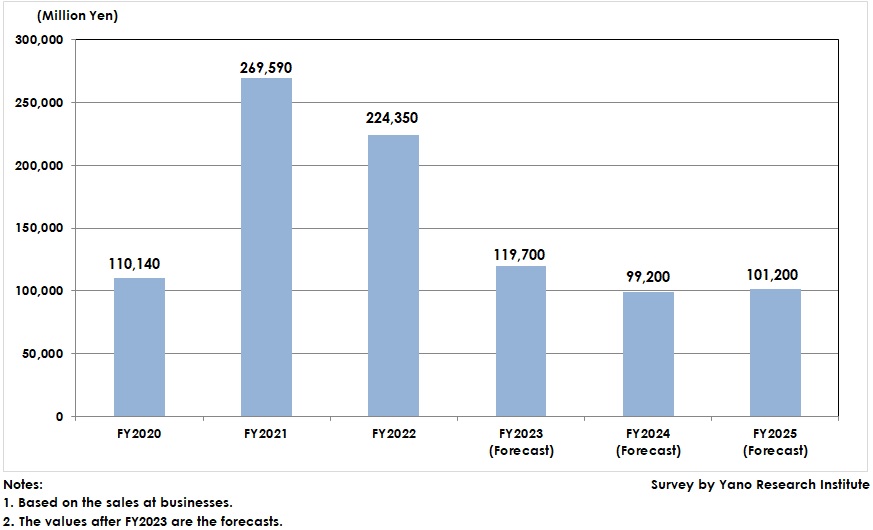No.3340
Public Service Outsourcing Market in Japan: Key Research Findings 2023
FY2022 Public Service Outsourcing Market Shrank to 83.2% of Previous Fiscal Year to 224400 Million Yen, due to Decreased COVID-19 Measures-Related Operations
Yano Research Institute (the President, Takashi Mizukoshi) carried out a survey on the domestic public service outsourcing market and found out the current market size and trends.

Market Overview
For FY2021, 70% of the entire public service outsourcing market was occupied by COVID-19 measures-related operations (counter service tasks and work at public health centers), including the tasks at consultation counter, at call center for vaccination reservations, printing and sending out the vaccination tickets, visitor guidance at large-scale vaccination centers, post-vaccination data entry, etc., which could be said as the occurrence of special demand or large-scale demand.
For FY2022, as the measures against the soaring prices for commodity and oil, outsourcing services occurred for financial aid operations such as funding support to households with children and households exempt from residential tax (due to low income), and to SMEs. However, the outsourcing demand was not as large scale as the COVID-19 measures-related operations in the previous fiscal year, and as the demand for COVID-19 operations declined by the latter half of the fiscal year, the public service outsourcing market for FY2022 was estimated as 224,350 million yen, 83.2% of the previous fiscal year.
Noteworthy Topics
Influence of Government Cloud
If the Government Cloud, the project aiming to integrate and standardize the digital infrastructure across ministries and municipalities becomes available, and if more residents use electronic methods for applications, it will widen the range of tasks and support provided by governmental or municipal employees, which may reduce the use of public service outsourcing.
Nevertheless, not all the work can be digitalized, because some jobs need to use paper and telephone, just like support for the elderly, which is likely for those human-intervention needed tasks to be kept as they are. In addition, even if digitalization is in progress, administrative services are basically done by person to person, which makes the counter service also to remain.
Note that if mission-critical tasks that have been done separately by municipality are standardized and digitalized through the Government Cloud, it is projected for multiple municipalities to establish joint back-office work centers. Then, adoption of public service outsourcing, with the use of joint back-office centers, for the operations relatively easy to place on the platform such as the childcare support operation, for instance, is projected to increase.
Future Outlook
FY2023 saw occurrence of outsourcing for the operations related to economic measures, because of necessity of financial support for the tax-exempted households and soaring commodity prices. While such a new demand may expand hereafter, decreased demand for the COVID-19 measures-related operations led the public service outsourcing market size for FY2023 to expect a significant fall to 119,700 million yen, 53.4% of the size of the previous fiscal year.
Although no large-scale special demand like during the corona outbreak can be expected anymore at this time, demand for outsourcing of office work that occurs regularly at municipalities, such as family registry operations, taxation, operations related to national health insurance and long-term care, child-related operations, is likely to increase, though slightly.
It is because the numbers of employees at many of municipalities are decreasing, despite public services becoming more diversified and complicated, as can see from expansion of welfare business for the elderly and increase in childcare centers aiming at solving the issue of children listed to wait for childcare center entrance. Another reason is reduced overtime work for municipality employees encouraged by the workstyle reform. With limited human resources, municipalities are not able to cope with the tasks and cannot help relying on the external resources. Furthermore, the government has been propelling the consignment to private sector for the work, fueling the introduction of public service outsourcing.
In addition to the above, now that the influence of large-scale demand like the COVID-measures-related operations has become smaller, the CAGR for the market from FY2020 to FY2025 is minus 1.7%, with the private service outsourcing market size for FY2025 expected to be 101,200 million yen.
Research Outline
2.Research Object: Public service outsourcing service providers
3.Research Methogology: Face-to-face interviews (including online) by expert researchers, and literature research
The Public Service Outsourcing Market
Public service outsourcing in this research refers to the outsourcing service for back-office work in municipalities. Specifically, it refers to the outsourcing service for the following operations: Family registry operations, taxation, operations related to national health insurance and long-term care, child-related operations, COVID-19 measures-related operations (including operations at public health centers), cash payment and financial aid operations, My-Number-related operations, economic vitalization operations, and general affairs & accounting operations.
<Products and Services in the Market>
Family registry operations, taxation, operations related to national health insurance and long-term care, child-related operations, COVID-19 measures-related operations (operations at public health centers), cash payment and financial aid operations, My-Number-related operations, economic vitalization operations, and general affairs & accounting operations.
Published Report
Contact Us
The copyright and all other rights pertaining to this report belong to Yano Research Institute.
Please contact our PR team when quoting the report contents for the purpose other than media coverage.
Depending on the purpose of using our report, we may ask you to present your sentences for confirmation beforehand.